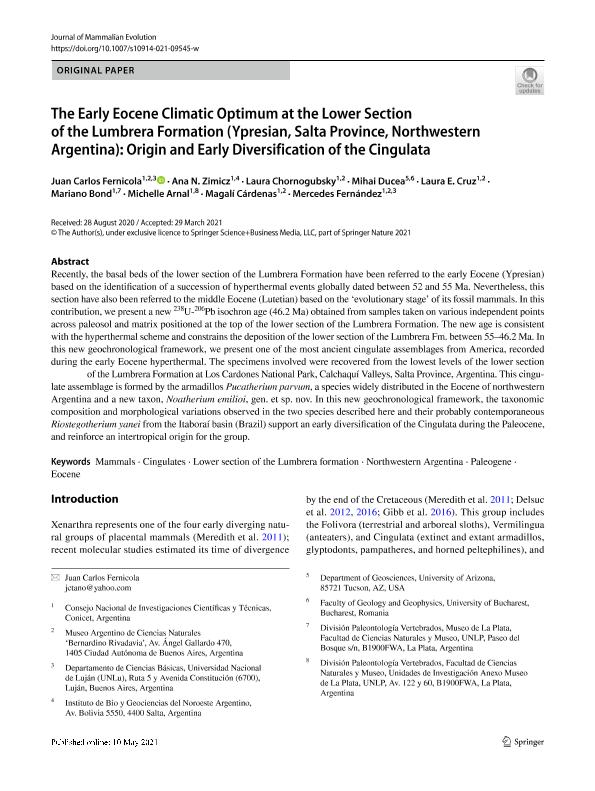Artículo
The Early Eocene Climatic Optimum at the Lower Section of the Lumbrera Formation (Ypresian, Salta Province, Northwestern Argentina): Origin and Early Diversification of the Cingulata
Fernicola, Juan Carlos ; Zimicz, Ana Natalia
; Zimicz, Ana Natalia ; Chornogubsky Clerici, Laura
; Chornogubsky Clerici, Laura ; Ducea, Mihai; Cruz, Laura Edith
; Ducea, Mihai; Cruz, Laura Edith ; Bond, Mariano
; Bond, Mariano ; Arnal, Michelle
; Arnal, Michelle ; Cardenas, Magali
; Cardenas, Magali ; Fernández, Mercedes
; Fernández, Mercedes
 ; Zimicz, Ana Natalia
; Zimicz, Ana Natalia ; Chornogubsky Clerici, Laura
; Chornogubsky Clerici, Laura ; Ducea, Mihai; Cruz, Laura Edith
; Ducea, Mihai; Cruz, Laura Edith ; Bond, Mariano
; Bond, Mariano ; Arnal, Michelle
; Arnal, Michelle ; Cardenas, Magali
; Cardenas, Magali ; Fernández, Mercedes
; Fernández, Mercedes
Fecha de publicación:
05/2021
Editorial:
Springer
Revista:
Journal of Mammalian Evolution
ISSN:
1064-7554
Idioma:
Inglés
Tipo de recurso:
Artículo publicado
Clasificación temática:
Resumen
Recently, the basal beds of the lower section of the Lumbrera Formation have been referred to the early Eocene (Ypresian) based on the identification of a succession of hyperthermal events globally dated between 52 and 55 Ma. Nevertheless, this section have also been referred to the middle Eocene (Lutetian) based on the ‘evolutionary stage’ of its fossil mammals. In this contribution, we present a new 238U-206Pb isochron age (46.2 Ma) obtained from samples taken on various independent points across paleosol and matrix positioned at the top of the lower section of the Lumbrera Formation. The new age is consistent with the hyperthermal scheme and constrains the deposition of the lower section of the Lumbrera Fm. between 55–46.2 Ma. In this new geochronological framework, we present one of the most ancient cingulate assemblages from America, recorded during the early Eocene hyperthermal. The specimens involved were recovered from the lowest levels of the lower section of the Lumbrera Formation at Los Cardones National Park, Calchaquí Valleys, Salta Province, Argentina. This cingulate assemblage is formed by the armadillos Pucatherium parvum, a species widely distributed in the Eocene of northwestern Argentina and a new taxon, Noatherium emilioi, gen. et sp. nov. In this new geochronological framework, the taxonomic composition and morphological variations observed in the two species described here and their probably contemporaneous Riostegotherium yanei from the Itaboraí basin (Brazil) support an early diversification of the Cingulata during the Paleocene, and reinforce an intertropical origin for the group.
Archivos asociados
Licencia
Identificadores
Colecciones
Articulos(MACNBR)
Articulos de MUSEO ARG.DE CS.NAT "BERNARDINO RIVADAVIA"
Articulos de MUSEO ARG.DE CS.NAT "BERNARDINO RIVADAVIA"
Citación
Fernicola, Juan Carlos; Zimicz, Ana Natalia; Chornogubsky Clerici, Laura; Ducea, Mihai; Cruz, Laura Edith; et al.; The Early Eocene Climatic Optimum at the Lower Section of the Lumbrera Formation (Ypresian, Salta Province, Northwestern Argentina): Origin and Early Diversification of the Cingulata; Springer; Journal of Mammalian Evolution; 28; 3; 5-2021; 621-633
Compartir
Altmétricas



